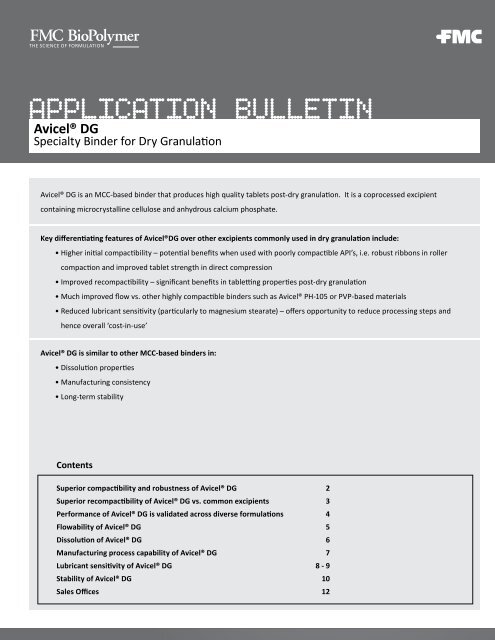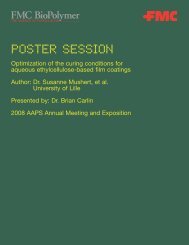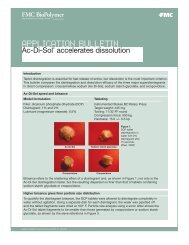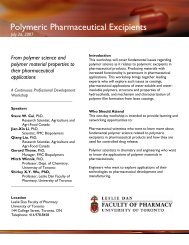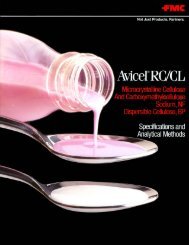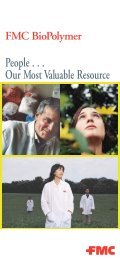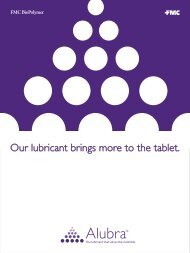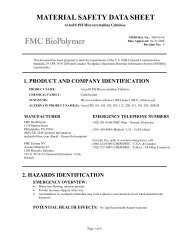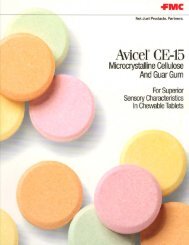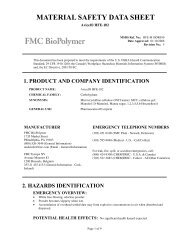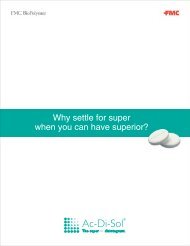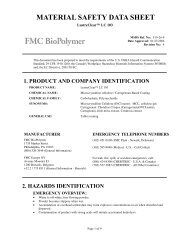Final DG Application Bulletin.pdf - FMC BioPolymer
Final DG Application Bulletin.pdf - FMC BioPolymer
Final DG Application Bulletin.pdf - FMC BioPolymer
Create successful ePaper yourself
Turn your PDF publications into a flip-book with our unique Google optimized e-Paper software.
THE SCIENCE OF FORMULATION<br />
APPLICATION BULLETIN<br />
Avicel® <strong>DG</strong><br />
Specialty Binder for Dry Granulation<br />
Avicel® <strong>DG</strong> is an MCC-based binder that produces high quality tablets post-dry granulation. It is a coprocessed excipient<br />
containing microcrystalline cellulose and anhydrous calcium phosphate.<br />
Key differentiating features of Avicel®<strong>DG</strong> over other excipients commonly used in dry granulation include:<br />
• Higher initial compactibility – potential benefits when used with poorly compactible API’s, i.e. robust ribbons in roller<br />
compaction and improved tablet strength in direct compression<br />
• Improved recompactibility – significant benefits in tabletting properties post-dry granulation<br />
• Much improved flow vs. other highly compactible binders such as Avicel® PH-105 or PVP-based materials<br />
• Reduced lubricant sensitivity (particularly to magnesium stearate) – offers opportunity to reduce processing steps and<br />
hence overall ‘cost-in-use’<br />
Avicel® <strong>DG</strong> is similar to other MCC-based binders in:<br />
• Dissolution properties<br />
• Manufacturing consistency<br />
• Long-term stability<br />
Contents<br />
Superior compactibility and robustness of Avicel® <strong>DG</strong> 2<br />
Superior recompactibility of Avicel® <strong>DG</strong> vs. common excipients 3<br />
Performance of Avicel® <strong>DG</strong> is validated across diverse formulations 4<br />
Flowability of Avicel® <strong>DG</strong> 5<br />
Dissolution of Avicel® <strong>DG</strong> 6<br />
Manufacturing process capability of Avicel® <strong>DG</strong> 7<br />
Lubricant sensitivity of Avicel® <strong>DG</strong> 8 - 9<br />
Stability of Avicel® <strong>DG</strong> 10<br />
Sales Offices 12
Superior compactibility and robustness of Avicel® <strong>DG</strong><br />
Formulation<br />
• 30% Ascorbic Acid (Vitamin C)<br />
• 69.5% Excipient<br />
• 0.5% Magnesium Stearate<br />
Roller Compactor settings<br />
• Compactor: Chilsonator IR‐520/D6A, Fitzpatrick<br />
• Pressure: 30 bars<br />
• Mill type: Bar rotor<br />
• Mill speed: 500 rpm<br />
• Rasping screen: 1.0 mm<br />
Tabletting settings<br />
• ESH Compaction Simulator<br />
• Dwell time: 6 ms (high tabletting speed)<br />
Excipient<br />
69.5%<br />
Blend 10 min<br />
Intermediate<br />
Blend<br />
Blend 2 min<br />
<strong>Final</strong> Blend<br />
Roller<br />
AscorbicAcid<br />
30%<br />
Sieve 1mm<br />
Pre-blend<br />
Sieve 1mm<br />
Magnesium<br />
Stearate 0.5%<br />
DirectCompression<br />
Comparison of tablet strength (initial and retained) at a certain tabletting pressure<br />
3.5<br />
3.0<br />
Direct Compression<br />
Dry<br />
and<br />
2.5<br />
Loss of<br />
2.0<br />
1.5<br />
59%<br />
78%<br />
1.0<br />
47% 67%<br />
0.5<br />
0.0<br />
Avicel®<strong>DG</strong><br />
Avicel®<br />
PH-102<br />
Avicel® PH-102 +<br />
Lactose Monohyd.<br />
DC (50:50)<br />
Avicel® PH-102 +<br />
DCP Dihyd. DC<br />
(65:35)<br />
The improved compactibility of Avicel®<br />
<strong>DG</strong> – initial and retained – over physical<br />
blends of MCC and a secondary (brittle)<br />
excipient offers benefits in Direct<br />
Compression and Dry Granulation.<br />
Improved compactibility of<br />
Avicel® <strong>DG</strong> over physical<br />
blends of MCC and brittle<br />
excipients<br />
Improved robustness,<br />
i.e. minimized loss of<br />
compactibility due to reworking,<br />
of Avicel® <strong>DG</strong> over MCC<br />
Avicel® <strong>DG</strong><br />
enhances<br />
tablet strength<br />
in direct<br />
compression<br />
Avicel® <strong>DG</strong><br />
enables the<br />
production of<br />
quality ribbons<br />
and tablets<br />
2
Superior recompactibility of Avicel® <strong>DG</strong> vs. common excipients<br />
Formulation<br />
• 30% Ascorbic Acid (Vitamin C)<br />
3.5<br />
• 69.5% Excipient<br />
• 0.5% Magnesium Stearate<br />
Roller Compactor settings<br />
• Compactor: Chilsonator IR‐220/<br />
L1A, Fitzpatrick<br />
• Pressure: 18 bars<br />
• Mill type: Bar rotor<br />
• Mill speed: 500 rpm<br />
• Rasping screen: 0.8 mm<br />
Tablet tensile strength (MPa)<br />
3.0<br />
2.5<br />
2.0<br />
1.5<br />
1.0<br />
0.5<br />
Common TS target<br />
Avicel® PH-101<br />
Avicel® PH-102<br />
Tabletting settings<br />
• ESH Compaction Simulator<br />
• Dwell time: 6 ms<br />
0.0<br />
0 50 100 150 200 250<br />
Tabletting presssure (MPa)<br />
The use of Avicel® <strong>DG</strong> enables the production of robust tablets at lower tabletting forces, which in turn minimizes equipment wear. Other<br />
common excipients (or blends of) may fail to yield satisfactory tablet strength and that may plateau at higher tabletting forces.<br />
Comparison of tablet strength, post‐granulation, at a certain tabletting pressure<br />
2.5<br />
Bars = 2 standard<br />
n = 14 (9 Avicel <strong>DG</strong> lots)<br />
Tablet tensile strength (MPa)<br />
at 150 MPa tabletting pressure<br />
2.0<br />
1.5<br />
1.0<br />
0.5<br />
0.0<br />
Avicel®<strong>DG</strong><br />
Avicel®<br />
PH-101<br />
Avicel®<br />
PH-102<br />
Avicel®<br />
PH-101 +<br />
An. DCP<br />
(75:25)<br />
Avicel®<br />
PH-101<br />
+ An.<br />
Lactose<br />
(50:50)<br />
Avicel®<br />
PH-102 +<br />
An. DCP<br />
(75:25)<br />
Avicel®<br />
PH-102<br />
+ An.<br />
Lactose<br />
(50:50)<br />
3
Performance of Avicel® <strong>DG</strong> is validated across diverse formulations<br />
Ascorbic Acid model with Magnesium Stearate<br />
Formulation<br />
• 3 0 % Ascorbic Acid (Vitamin C)<br />
• 69.5% Excipient<br />
• 0.5% Magnesium Stearate<br />
Roller Compactor settings<br />
• Compactor: Chilsonator IR‐220/L1A, Fitzpatrick<br />
• Pressure: 18 bars<br />
• Mill type: Bar rotor<br />
• Mill speed: 500 rpm<br />
• Rasping screen: 0.8 mm<br />
Tabletting settings<br />
• ESH Compaction Simulator<br />
• Dwell time: 6 ms (high tabletting speed, closer<br />
reflection of the actual production environment)<br />
APAP model with Alubra® PG‐100<br />
Formulation<br />
• 4 0 % Acetaminophen (Paracetamol)<br />
• 57.5% Excipient<br />
• 2% Ac‐Di‐Sol<br />
• 0.5% Alubra® PG‐100<br />
Roller Compactor settings<br />
• Compactor: Chilsonator IR‐220/L1A, Fitzpatrick<br />
• Pressure: 20 bars<br />
• Mill type: Bar rotor<br />
• Mill speed: 500 rpm<br />
• Rasping screen: 0.8 mm<br />
Tabletting settings<br />
• ESH Compaction Simulator<br />
• Dwell time: 60 ms<br />
Comparison of compaction properties across multiple formulations<br />
Tablet tensile strength (MPa)<br />
at 150MPa tabletting pressure<br />
2.5<br />
2.0<br />
1.5<br />
1.0<br />
0.5<br />
AscorbicAcid high speed<br />
APAP low speed<br />
0.0<br />
Avicel®<strong>DG</strong><br />
Avicel® PH-101 Avicel® PH-101 +<br />
An. DCP (75:25)<br />
Avicel® PH-101 +<br />
An. Lactose (50:50)<br />
The superior performance of Avicel® <strong>DG</strong> was observed in various models, with different API’s at different levels, different lubricants, compacted<br />
at various pressures and tabletted at various speeds.<br />
4
Flowability of Avicel® <strong>DG</strong><br />
Carr’s index & FT4 Powder Rheometer – Flowability of Avicel® <strong>DG</strong> is similar to that of Avicel® PH-101<br />
Product<br />
LOD<br />
(%)<br />
LBD<br />
(g/cc)<br />
D50<br />
(µm)<br />
Hausner<br />
Carr’s index<br />
(%)<br />
FT4 Powder Rheometer Results<br />
FRI SE (mJ/g) UYS (kPa)<br />
Avicel® <strong>DG</strong> 4.3<br />
0.32<br />
42<br />
1.6<br />
37<br />
1.4<br />
7.9<br />
1.8<br />
Avicel® PH-101<br />
4.2<br />
0.30<br />
49<br />
1.6<br />
38<br />
1.5<br />
8.3<br />
3.9<br />
Avicel® PH-102<br />
4.1<br />
0.29<br />
105<br />
1.5<br />
34<br />
1.2<br />
6.8<br />
3.1<br />
Avicel® PH-105<br />
3.7<br />
0.24<br />
20<br />
2.0<br />
50<br />
2.2<br />
18.1<br />
4.5<br />
LOD: loss on drying (%)<br />
LBD: loose bulk density (g/cc)<br />
D50: median particle size determined by laser diffraction (μm)<br />
Hausner ratio: tapped density at 2500 taps / loose bulk density<br />
Carr’s index: (tapped density at 2500 taps – loose bulk density) /<br />
tapped density at 2500 taps x 100 (%)<br />
FRI: flow rate index, higher FRI indicates flow rate sensitive and very<br />
cohesive powder<br />
SE: specific energy, energy needed to displace the powder<br />
UYS: unconfined yield strength, stress at which a bridge will collapse in<br />
a hopper outlet<br />
Hausner ratio – Avicel® <strong>DG</strong> flows similarly to Avicel® PH-101 and significantly better than Avicel® PH-105<br />
2.2<br />
Hausner ratio<br />
Tapped density / loose bulk density<br />
2.0<br />
1.8<br />
1.6<br />
1.4<br />
1.2<br />
1.0<br />
0.8<br />
Avicel® <strong>DG</strong><br />
Avicel® PH-101<br />
Avicel® PH-102<br />
Avicel® PH-105<br />
0 500 1000 1500 2000 2500<br />
Number of taps<br />
The flowability of Avicel® <strong>DG</strong> is comparable to that of Avicel® PH-101, but significantly better than that of Avicel® PH-105. Indeed Avicel® <strong>DG</strong><br />
and Avicel® PH-101 share several physico‐chemical properties, such as loss on drying (moisture content), loose bulk density and particle size.<br />
The presence of Calcium Phosphate in Avicel® <strong>DG</strong> may minimize unconfined yield strength and potentially reduce bridging in hoppers and<br />
feeding units.<br />
5
Dissolution of Avicel® <strong>DG</strong><br />
Avicel® <strong>DG</strong> demonstrated similar dissolution rates to other binder substitutes across different formulations.<br />
APAP model<br />
Formulation<br />
• 40% APAP (Paracetamol<br />
• 57.5% Excipient<br />
• 2% Ac‐Di‐Sol<br />
• 0.5% Alubra® PG‐100<br />
Roller Compactor settings<br />
• Compactor: Chilsonator IR‐<br />
220/L1A, Fitzpatrick<br />
• Pressure: 20 bars<br />
Tabletting settings<br />
• ESH Compaction Simulator<br />
• Dwell time: 60 ms<br />
Metformin HCl model<br />
Formulation<br />
• 50% Metformin<br />
• 47.5% Excipient<br />
• 2% Ac‐Di‐Sol<br />
• 0.5% Alubra® PG‐100<br />
Roller Compactor settings<br />
• Compactor: Chilsonator IR‐<br />
220/L1A, Fitzpatrick<br />
• Pressure: 25 bars<br />
Tabletting settings<br />
• ESH Compaction Simulator<br />
• Dwell time: 60 ms<br />
HCTZ model<br />
Formulation<br />
• 10% Hydrochlorothiazide<br />
• 87.5% Excipient<br />
• 2% Ac‐Di‐Sol<br />
• 0.5% Alubra® PG‐100<br />
Roller Compactor settings<br />
• Compactor: Chilsonator IR‐ 220/L1A,<br />
Fitzpatrick<br />
• Pressure: 18 bars<br />
Tabletting settings<br />
• ESH Compaction Simulator<br />
• Dwell time: 6 ms (high tabletting speed)<br />
HCTZ Model, poorly soluble API, lowest release rate of the three models considered<br />
100<br />
90<br />
HCTZ Percent release (%)<br />
80<br />
70<br />
60<br />
50<br />
40<br />
30<br />
20<br />
Avicel® <strong>DG</strong><br />
Avicel® PH-101<br />
Avicel® PH-105<br />
Avicel® PH-101 + An. Lactose (50:50)<br />
Avicel® PH-101 + An. DCP (75:25)<br />
0 10 20 30 40 50 60<br />
Time (min)<br />
APAP HCl HCTZ<br />
USP acceptance criteria > 80% (Q) in 30 min > 70% (Q) in 45 min > 60% (Q) in 60 min<br />
Avicel® <strong>DG</strong><br />
95 ± 2.4<br />
100<br />
99 ± 0.5<br />
Avicel® PH-101<br />
97 ± 1.2<br />
100<br />
98 ± 0.4<br />
Avicel® PH-105<br />
100 ± 0.5<br />
100<br />
95 ± 0.8<br />
Avicel® PH-101 + An. DCP (75:25)<br />
84 ± 7.1*<br />
99 ± 0.5<br />
96 ± 0.6<br />
Avicel® PH-101 + An. Lactose (50:50)<br />
99 ± 0.8<br />
100<br />
93 ± 0.8<br />
Mean of 6 tablets ± standard deviation<br />
* 2 tablets out of 6 released less than 85% of APAP in 30 minutes. This formulation failed the stage 1 acceptance criteria, i.e. each unit is not less<br />
than Q + 5%, where Q is the amount of dissolved active ingredient specified in the individual monograph.<br />
6
Manufacturing process capability of Avicel® <strong>DG</strong><br />
Formulation<br />
• 30% Ascorbic Acid (Vitamin C)<br />
• 69.5% Excipient<br />
• 0.5% Magnesium Stearate<br />
Roller Compactor settings<br />
• Compactor: Chilsonator IR‐220/L1A,<br />
Fitzpatrick<br />
• Pressure: 18 bars<br />
• Mill type: Bar rotor<br />
• Mill speed: 500 rpm<br />
• Rasping screen: 0.8 mm<br />
Tablet tensile strength (MPa)<br />
3.5<br />
3.0<br />
2.5<br />
2.0<br />
1.5<br />
1.0<br />
0.5<br />
--- 2009 (3 lots)<br />
--- 2011 (3 lots)<br />
--- 2012 (3 lots)<br />
Tabletting settings<br />
• ESH Compaction Simulator<br />
• Dwell time: 6 ms (high tabletting speed)<br />
0.0<br />
0 50 100 150 200 250<br />
Time (min)<br />
Mean tensile strength = 2.03 MPa (standard deviation ± 0.08 MPa)<br />
2.5<br />
Tablet tensile strength (MPa)<br />
at 150 MPa tabletting pressure<br />
2.0<br />
1.5<br />
1.0<br />
0.5<br />
0.0<br />
Manufacturing year – Lot number<br />
A total of 9 Avicel® <strong>DG</strong> lots, produced over a period of three years, confirm the excellent production and lot‐to‐lot consistency.<br />
7
Lubricant sensitivity of Avicel® <strong>DG</strong><br />
Formulation<br />
• 30% Ascorbic Acid (Vitamin C)<br />
• 69.5% Excipient<br />
• 0.5% Magnesium Stearate<br />
Roller Compactor settings<br />
• Compactor: Chilsonator IR‐220/<br />
L1A, Fitzpatrick<br />
• Pressure: 18 bars<br />
• Mill type: Bar rotor<br />
• Mill speed: 500 rpm<br />
• Rasping screen: 0.8 mm<br />
Tabletting settings<br />
• ESH Compaction Simulator<br />
• Dwell time: 6 ms (high tabletting<br />
speed)<br />
Process A – Two blending steps<br />
1. API & Excipient<br />
2. Lubrication<br />
Process B – One blending step<br />
1. API & Excipient & Lubricant<br />
Excipient<br />
69.5%<br />
AscorbicAcid<br />
30%<br />
Excipient<br />
69.5%<br />
Magnesium<br />
Stearate 0.5%<br />
AscorbicAcid<br />
30%<br />
Sieve 1mm<br />
Pre-blend<br />
Sieve 1mm<br />
Blend 10 min<br />
Intermediate<br />
Blend<br />
Magnesium<br />
Stearate 0.5%<br />
Sieve 1mm<br />
Pre-blend<br />
Blend 10 min<br />
Sieve 1mm<br />
<strong>Final</strong> Blend<br />
Blend 2 min<br />
Roller<br />
<strong>Final</strong> Blend<br />
Roller<br />
Impact of blending steps on tablet strength<br />
Tablet tensile strength (MPa)<br />
3.5<br />
3.0<br />
2.5<br />
2.0<br />
1.5<br />
1.0<br />
0.5<br />
Avicel® <strong>DG</strong> + 0.5% MgSt<br />
One blending step, Process B<br />
Avicel® <strong>DG</strong> + 0.5% MgSt<br />
Two blending steps, ProcessA<br />
Avicel® PH-101 + 0.5% MgSt<br />
Two blending steps, Process A<br />
Avicel® PH-101 + 0.5% MgSt<br />
One blending step, Process B<br />
Standard MCC is more lubricant<br />
sensitive than Avicel® <strong>DG</strong> and would<br />
therefore show signs of lamination<br />
and capping if the lubricant is<br />
incorporated in the initial blend.<br />
Therefore, a secondary and final<br />
lubricant blending step would be<br />
required. Avicel® <strong>DG</strong> yields highquality<br />
tablets in formulations<br />
blended in a single step, offering<br />
significant benefits from process<br />
simplification and cycle‐time<br />
reduction.<br />
0.0<br />
0 50 100 150 200 250<br />
Tabletting pressure (MPa)<br />
8
Lubricant Sensitivity of Avicel® <strong>DG</strong> (continued)<br />
Formulation<br />
• 30% Ascorbic Acid (Vitamin C)<br />
• 69.5% Excipient<br />
Excipient<br />
69.5%<br />
AscorbicAcid<br />
30%<br />
• 0.5% Magnesium Stearate or Alubra®<br />
Sieve 1mm<br />
PG‐100<br />
Roller Compactor settings<br />
Blend 10 min<br />
• Compactor: Chilsonator IR‐520/D6A,<br />
Fitzpatrick<br />
Intermediate<br />
Blend<br />
Lubricant<br />
0.5%<br />
• Pressure: 30 bars<br />
• Mill type: Bar rotor<br />
Pre-blend<br />
• Mill speed: 500 rpm<br />
Sieve 1mm<br />
• Rasping screen: 1.0 mm<br />
Tabletting settings<br />
Blend 2 min<br />
• ESH Compaction Simulator<br />
• Dwell time: 6 ms (high tabletting speed)<br />
<strong>Final</strong> Blend<br />
Roller<br />
Comparison of tablet strength using different lubricants<br />
4.5<br />
4.0<br />
3.5<br />
Tablet tensile strength (MPa)<br />
3.0<br />
2.5<br />
2.0<br />
1.5<br />
1.0<br />
0.5<br />
Common TS target<br />
Avicel® PH-101 + 0.5% MgSt<br />
0.0<br />
0 50 100 150<br />
200 250<br />
Tabletting pressure (MPa)<br />
Avicel® <strong>DG</strong> can significantly improve tablet strengths over standard MCC. This benefit is accentuated with the use of Alubra® PG‐100 (Sodium<br />
Stearyl Fumarate), which may assist in formulating with poorly compactible and/or poorly soluble API’s.<br />
9
Stability of Avicel® <strong>DG</strong><br />
Long term storage at 25°C and 60% RH<br />
N/A: not available, Lot #1: XN09820884, Lot #2: XN09820885, Lot #3: XN09820886<br />
Long term storage at ambient conditions, Brussels, Belgium<br />
Mean temperature: 21°C (min: 15°C, max: 25°C), Mean relative humidity: 43% (min: 16%, max: 76%)<br />
0<br />
N/A: not available, Lot #1: XN09820884, Lot #2: XN09820885, Lot #3: XN09820886<br />
Avicel® <strong>DG</strong> is less hygroscopic than MCC<br />
Avicel® PH-101<br />
* 25°C and 60% RH simulate long term storage conditions<br />
10
Notes<br />
11
Sales Offices<br />
United States<br />
Philadelphia, PA<br />
Sales/Technical Assistance:<br />
Tel: 1-215-299-6534<br />
Fax: 1-215-299-6669<br />
Customer Service:<br />
Tel: 1-800-526-3646<br />
Fax: 1-215-299-6475<br />
Europe<br />
Brussels, Belgium<br />
Sales/Technical Assistance:<br />
Tel: +32-2-775-8311<br />
Fax: +32-2-775-8300<br />
Customer Service:<br />
Tel: +353-21-4354-133<br />
Fax: +352-21-4353-057<br />
Asia-Pacific<br />
Shanghai<br />
Tel: +86-21-5427-1177<br />
Fax: +86-21-5427-0193<br />
Tokyo, Japan<br />
Tel: +81-3-3402-3739<br />
Fax: +81-3-3402-3700<br />
Singapore<br />
Tel: +65-6430-0383<br />
Fax: +65-6430-0399<br />
Latin America<br />
Montevedeo, Uruguay<br />
Tel/Fax: +5982-604-3030<br />
Tel/Fax: +5982-604-3104<br />
Middle East<br />
Amman, Jordan<br />
Tel: +962-5-4618150<br />
Fax: +962-5-4618156<br />
Visit our website at www.fmcbiopolymer.com<br />
E-mail: pharm_info@fmc.com<br />
Patents<br />
<strong>FMC</strong> Corporation is owner and/or licensee of several patents related to its products. The products, processes and uses of such products referred to in this document<br />
may be covered by one or more patents or pending applications in the United States and/or other countries. <strong>FMC</strong> does not warrant against any infringement claim<br />
arising from the sale and/or use of any <strong>FMC</strong> product in combination with other materials; the use of any <strong>FMC</strong> product in the operation of any process; any <strong>FMC</strong><br />
product manufactured to a customer’s designs or specifications; or any <strong>FMC</strong> product manufactured by any process requested by a purchaser.<br />
Product Suitability<br />
The information contained in this document (as well as any advice or assistance) is provided by <strong>FMC</strong> only as a courtesy and is intended to be general in nature. Any<br />
uses suggested by <strong>FMC</strong> are presented only to assist our customers in exploring possible applications. <strong>FMC</strong> makes no warranty, express or implied, as to its accuracy<br />
or completeness, or the results to be obtained from such information, advice or assistance. Each customer is solely responsible for determining whether the <strong>FMC</strong><br />
products are suitable for such customer’s intended use, and for obtaining any necessary governmental registrations and approvals for such customer’s production,<br />
marketing, sale, use and/or transportation of finished goods using or incorporating the <strong>FMC</strong> products.<br />
<strong>FMC</strong> logo, Alubra and Avicel are trademarks of <strong>FMC</strong> Corporation. ©<strong>FMC</strong> Corporation 2012. All rights reserved.<br />
Chilsonator is a trademark of The Fitzpatrick Company.


